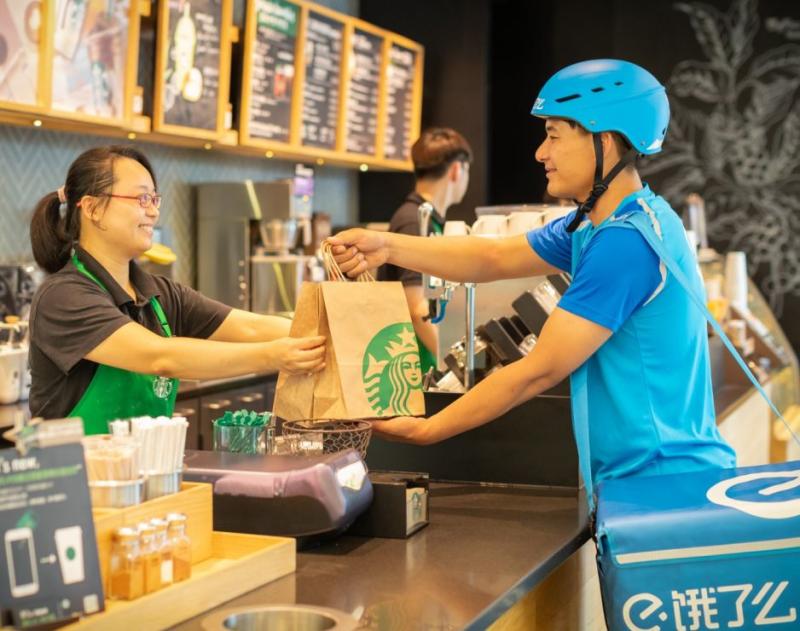Starbucks Ramps Up Personalization, Drive-Thru and Delivery for 2019
Q4 2018
Starbucks saw comparable store sales up 3% globally, driven by 4% growth in the U.S.
Coffee giant Starbucks is investing in personalization, delivery, and drive-thrus, as it heads into the holiday season and 2019.
Meanwhile, the retailer’s top priority of late has been enhancing the in-store experience. In Q3, Starbucks set a target to cut up to 50% of current in-store administrative tasks by the end of fiscal year 2019, hoping the move could help gain “up to two to three hours daily” for associates to focus on customer connections.
“We haven't always made it easy for our partners to focus on their customers and truly lead in the moment,” said Starbucks’ COO Rosalind G. Brewer. “Complex tasks and unclear expectations often get in the way. This is the key reason we continue to focus on driving in-store improvements and tangible changes that put our customers first.”
Brewer reported Starbucks made “solid progress against this goal in Q4, redeploying up to one-and-a-half hours per day of noncustomer-facing tasks to customer-facing activity, depending on the store.”
The company initiated automated inventory in 32 stores for all food products and rolled out training to build leadership to facilitate “creating best moments” in cafés. Customer connection scores, which include ratings on cleanliness and speed of service, showed improvement across all dayparts and regions in Q4.
Now, as it enters the holiday season, Starbucks is focusing in on three things to drive the customer experience.
“Starbucks record Q4 performance reflected meaningful improvement in virtually every critical operating metric compared to Q3," said Kevin Johnson, CEO. “As we enter fiscal 2019, we are executing against a clear growth agenda, with a focus on our long-term growth markets of the U.S. and China.”
Drive-Thru
A testament the shoppers’ desires for convenience, drive-thru, out-the-window and Mobile Order and Pay combined grew to more than 50% of the way Starbucks’ customers are ordering, up more than 10 percentage points in two years. Mobile Order and Pay represented 14% of U.S. company-operated transactions in the quarter.
Last quarter, Starbucks stores with drive-thru outperformed café comp, while more than 80% of new U.S. Starbucks locations that opened in the last year featured drive-thrus. This format will be a continued focus into FY 2019, the retailer said, as it plans to add more than 600 net new stores in the Americas.
Delivery
Starbucks started testing delivery in Miami this summer and the results are “promising,” Brewer reported.
Internationally, Starbucks' delivery partnership with Alibaba began September, launching in Beijing and Shanghai. Delivery has been expanded to all Starbucks stores in Beijing and Shanghai, and 11 cities in China. Across China, Starbucks expects to bring Starbucks Delivers to more than 2,000 stores across 30 cities by the end of this calendar year.
Personalization
Starbucks has been working on “reframing” its marketing and technology teams, which has led to a combination of its consumer insights, partner analytics and marketing analytics functions into a “new center of excellence.”
“As we elevate our ability to understand customers and drive that understanding through all of our customer-facing functions, we see significant benefits in combining these groups,” said Brewer. “The opportunity to unleash and democratize information across the entire enterprise, to ensure our customer is at the center of our day-to-day decision-making is powerful. And by having a smaller team and an easily accessible single source of the truth, we are enabling faster decision-making and delivering more relevant products and improved experiences.”
Active U.S. Starbucks Rewards (SR) members grew to 15.3 million, up 15% versus last year, which represented the strongest growth in seven quarters. SR members drive nearly 40% of tender in the U.S.
Additionally, digitally registered customers grew from 6 million at the end of Q3 to 10 million at the end of Q4, as the company developed its digital strategy for casual customers.
“Currently, we're engaging with these customers directly via e-mail with offers like Happy Hour,” noted Brewer. “But as we get to know who they are and what they want, we'll tailor specific offers with the goal of converting them to our SR program.”
“We're just beginning to send offers to this group of people,” noted CMO Matthew Ryan. “We have not yet begun to personalize and that's something we expect to do later this year. Remember that we're not in the business of creating digital relationships for digital relationship's sake.
“They're an enabler for us to communicate and talk to our customers. It is a way that we go to market. And by building that capability, it allows us to be less reliant on media and to be more reliant on customers pulling information from us in the future.”





